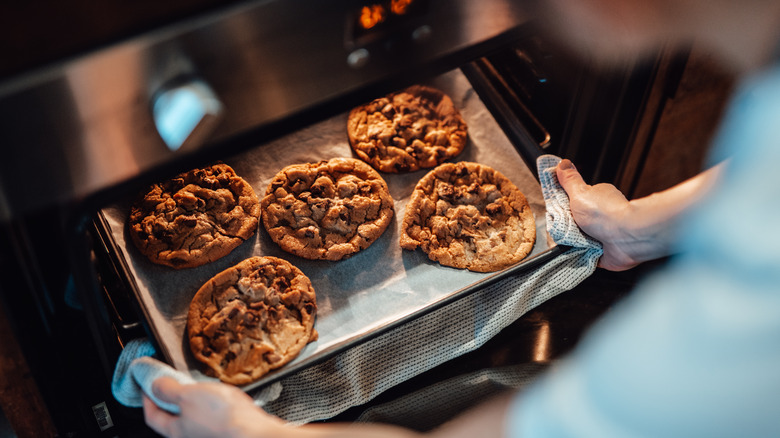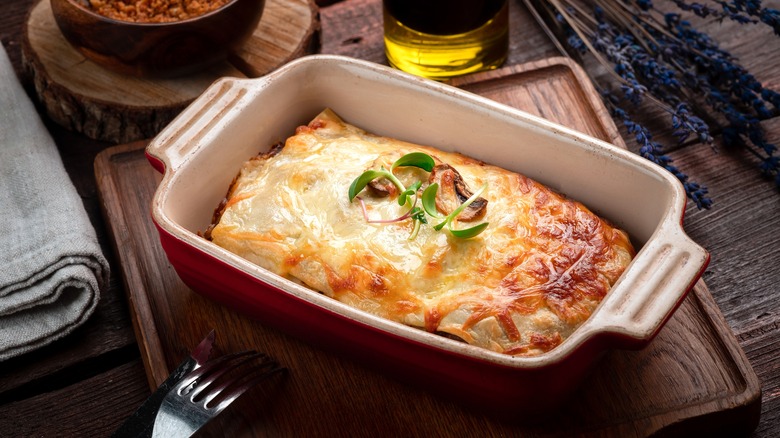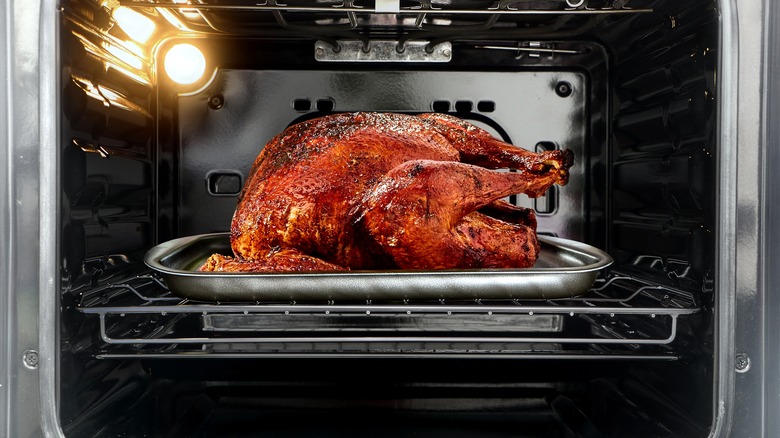How You Arrange Food In Your Oven Matters – Here's How To Do It Correctly
You might not think twice before popping a pizza in the topmost rack of your oven — or a tray of those chewy pumpkin chocolate chip cookies in the bottommost one. How much of a difference can it possibly make if you've set the oven to the right temperature? Well, a lot, it turns out. The way you arrange food inside the appliance is very important, and doing it wrong can have a huge impact on the color and texture of your food.
It all has to do with how an oven functions. Ovens operate differently based on their models, but in general, most conventional ones have two heating points: One is located on the top, and the other sits at the very bottom. Both these elements distribute heat differently, and proximity to either one plays a crucial role in determining how fast or well your food cooks.
For instance, both elements turn on when an oven is preheated. However, the one located at the bottom will then turn off and on in intervals to maintain the temperature inside the appliance. This can be an advantage if you place the right foods next to it, but it can also yield an uneven bake if you aren't careful. Another thing to note is that hot air rises from the bottom to the top, meaning the upper racks are generally the hottest areas inside the oven — which can be a good or a bad thing, depending on what's sitting up there.
When to use the top and bottom racks
The topmost rack of an oven is where the heat is direct, at its highest, and most intense. This makes it ideal for broiling meats, vegetables, and anything whose crusts could do with a nice char and sear — think casseroles, lasagnas, or anything covered in bubbling cheese really. The direct heat here can also caramelize sugar in a flash, giving that crunchy finish to dishes like créme brûlées made at home, and sweet, brown sugar-topped bananas. However, it's important to keep a watch on the oven when cooking in the top rack, as the high heat can quickly burn things too.
On the flip side, bottom racks are for foods that require short bursts of intense and direct heat from below to cook properly, say pizzas, breads, and pies for example. Placing them here can be the trick to avoiding those soggy crusts and ensuring that they are nice and crisp at the bottom too.
If you're worried about the food not cooking properly at the top, you can always transfer it to the topmost rack to finish things off at the end. This will give it a broil so that the top layer has an equally crisp, golden-brown crust as well, especially in pizzas where the cheese could do with a bit of browning once the base is crisp enough. Or, there's always the option of using a pizza stone to fix uneven oven heat too.
When in doubt, use the middle spot
The general rule of thumb with arranging food in an oven is to place dishes at the bottom if the bottom layer needs crisping, at the top if its top layer needs to be a crust, and in the middle for everything else. This is because the middle rack is where an oven's heat circulates more evenly. It's where you would put most foods that require a uniform cook — think brownies, cookies, and cakes that need to rise into fluffy sponges, as well as roasted meats and pasta bakes. Delicate foods also bake better in the middle rack, as do all items that tend to cook quickly.
That said, the rules do change slightly if you're baking two things at once. In that case, slide one tray in a rack at the top third area of the oven, and the other in the bottom third. Swap the two about midway through the cook, and you'll get an even bake on both items. However, remember that your overall cooking time will increase slightly when baking multiple items.
It's also a good idea to rotate your food once you're halfway through the cooking for an even bake, no matter which part of the oven it is placed in. It helps to know where your oven's hot spots are as well — zones that are hotter or cooler. This can similarly help you determine where to place your dishes.



